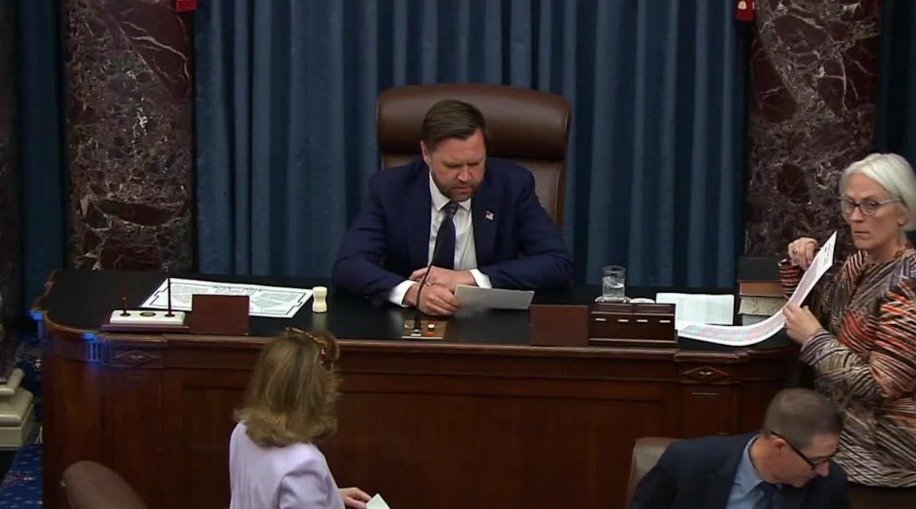Ohio political leaders were front and center in a major legislative milestone for former President Donald Trump, as the U.S. Senate passed his sweeping tax and budget bill, commonly referred to as the “Big Beautiful Bill.” The legislation, considered one of Trump’s landmark fiscal achievements, brought dramatic changes to the federal tax code and restructured aspects of government spending. While the bill was praised by some as a victory for economic growth, critics expressed deep concern over its potential impact on healthcare—particularly Medicaid—raising fears that thousands of Americans could lose coverage.
Ohio’s Role in the Legislative Push
Key figures from Ohio played a critical part in rallying support for the bill, both within the state and on Capitol Hill. U.S. Senator Rob Portman (R-OH), a prominent Republican voice in the Senate, helped shape provisions of the bill that aimed to offer tax relief for middle-class families and small businesses. Portman, along with other Ohio Republicans, emphasized the importance of simplifying the tax code and boosting economic competitiveness.
Congressman Jim Jordan, another influential Ohio Republican and a member of the House Freedom Caucus, also lent his support. Jordan had previously expressed concern over excessive government spending but backed the bill after provisions were added to address conservative budget priorities. Ohio Governor at the time, John Kasich, while not directly involved in the legislative process, had earlier voiced opposition to some of the proposed Medicaid changes, highlighting internal divisions within Ohio’s leadership.
Contents and Goals of the ‘Big Beautiful Bill’
Dubbed the “Big Beautiful Bill” by Trump himself, the legislation aimed to reshape the American economic landscape. Its primary objectives included:
-
Massive Tax Cuts: Reductions in corporate tax rates and individual income taxes.
-
Simplification of the Tax Code: Elimination of several deductions and loopholes.
-
Encouraging Business Investment: Incentives for companies to repatriate profits held overseas and invest domestically.
-
Reduced Government Spending: Long-term plans to cut funding to certain federal programs, including entitlements like Medicaid.
The bill was positioned as a major win for Republicans ahead of upcoming elections, giving them a tangible legislative accomplishment to campaign on.
Concerns Over Medicaid and Healthcare Access
While proponents celebrated the bill’s passage as a step toward economic renewal, healthcare advocates and Democratic leaders voiced serious concerns—particularly regarding its impact on Medicaid. The legislation included spending cuts and restructuring mechanisms that critics argue would lead to a loss of coverage for vulnerable populations.
Ohio, with its significant Medicaid expansion under the Affordable Care Act (ACA), was seen as a bellwether for the potential impact. Estimates suggested that tens of thousands of Ohioans could be affected by the changes. Community health organizations warned of increased strain on hospitals, particularly in rural areas, and a rise in uninsured rates.
Public Reaction and Protests
Following the bill’s approval, reactions across Ohio were mixed. Supporters hailed it as a long-overdue reform that would spur job growth and put more money in people’s pockets. Many small business owners and conservative groups applauded the provisions related to tax relief and deregulation.
However, opposition groups organized rallies and protests in cities such as Columbus, Cleveland, and Cincinnati. Healthcare workers, union leaders, and low-income residents expressed fears that the bill would prioritize tax cuts for corporations over essential services for the public. Social media campaigns also amplified voices of those who believed the bill threatened to undo years of healthcare progress.
Political Ramifications for Ohio
The legislation’s passage had significant political implications for Ohio leaders. For Senator Portman, the bill added to his credentials as a key figure in shaping national fiscal policy. However, the backlash from constituents over healthcare cuts posed challenges for other Republicans in the state, especially those in swing districts.
As the 2025 election cycle approaches, the “Big Beautiful Bill” is expected to remain a major point of debate in Ohio. Democrats are likely to focus on the bill’s impact on Medicaid and social programs, while Republicans aim to highlight economic growth and tax relief.
Looking Ahead
While the bill marks a significant achievement for the Trump administration and its allies, its long-term effects remain uncertain. Economists and policy experts are divided on whether the projected economic growth will offset the increased deficit and the strain on public services. In Ohio, the balance between fiscal reform and social responsibility continues to drive political discourse.
The ultimate legacy of the “Big Beautiful Bill” in Ohio will likely depend on how its impacts unfold in communities across the state. With leaders from Ohio continuing to influence national policy, the state remains at the heart of America’s evolving economic and healthcare landscape.

















